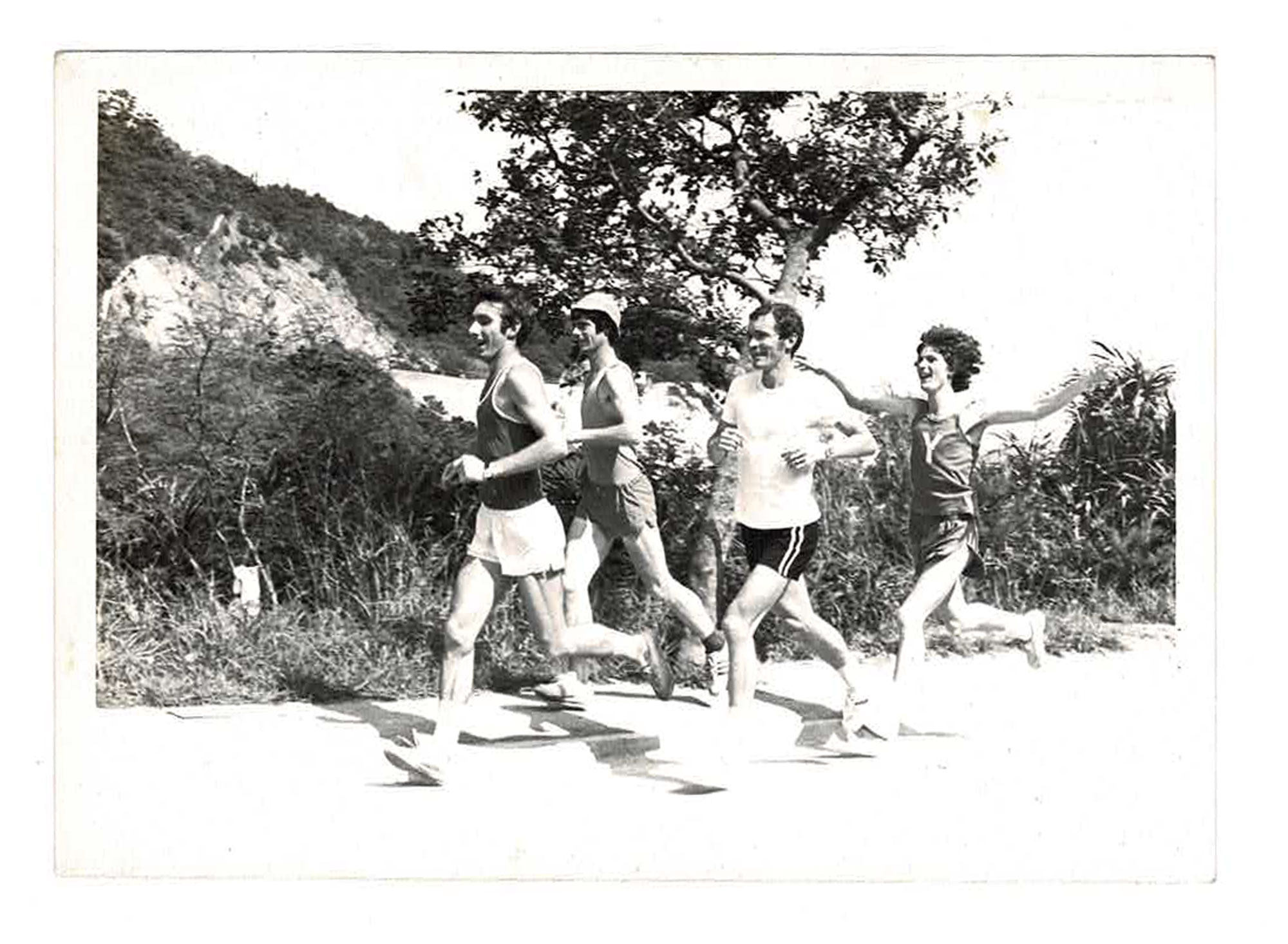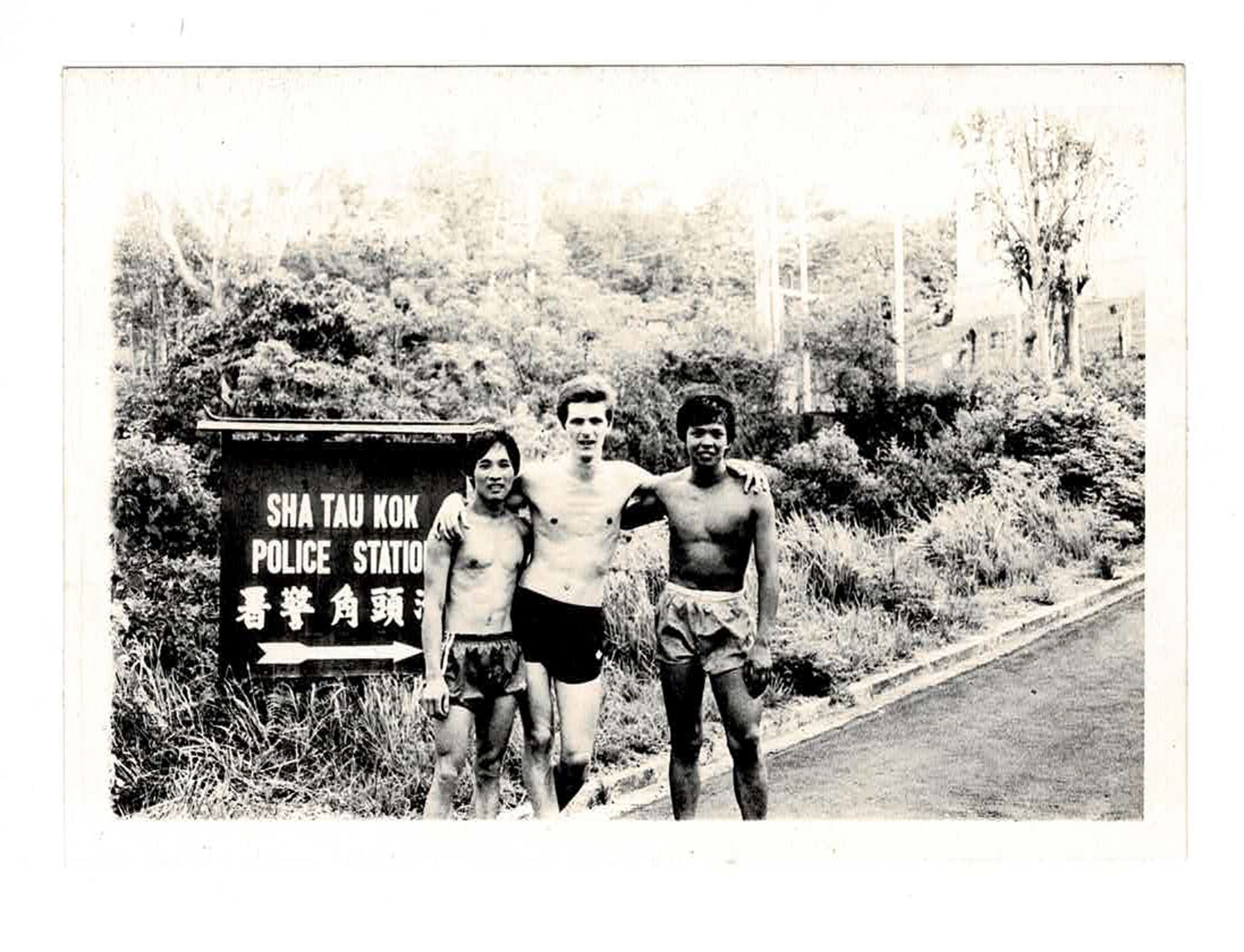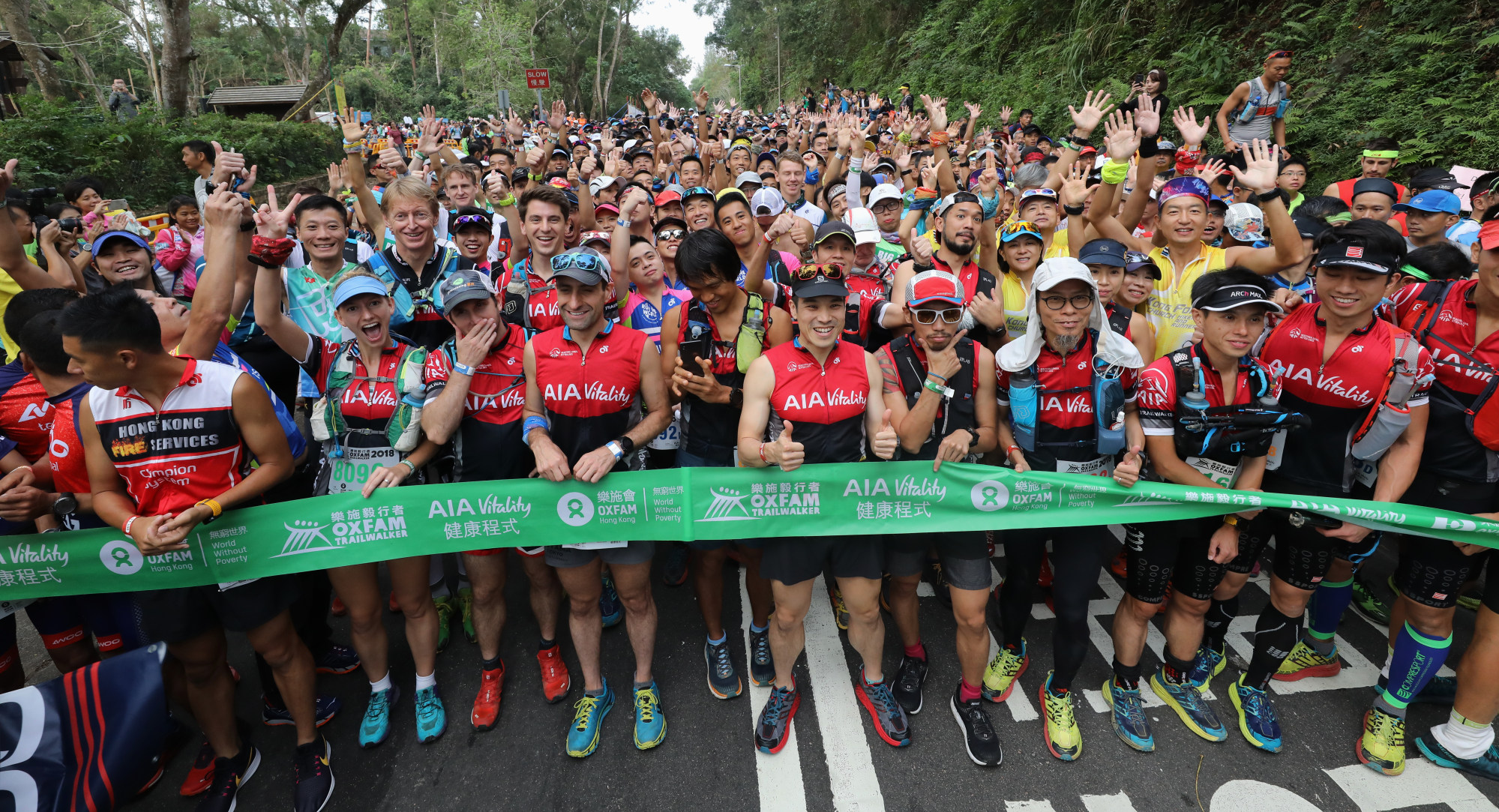
- In 1976, a group of five ran from Hong Kong Island’s most southerly district to its most northerly police station in what would become city’s first ultra event
- Two decades before that, one lonely runner set a world record running on his own around an athletics track
Ultra running is now almost synonymous with Hong Kong, which boasts the kind of daunting terrain and conditions perfect for races that draw tens of thousands of hardy competitors every year.
So it’s hard to believe that the first recorded ultra marathon in Hong Kong only took place in 1956, and that few people even seemed to notice at the time.
Perhaps they should have done – it produced a world record, a note of which was hidden in an article in the Hong Kong Marathon programme from 1979.
The 32-year-old Bob Pape, a member of the British Navy who was posted to Hong Kong and was anxious to qualify for the Melbourne Olympics, ran a marathon in two hours, 25 minutes and six seconds, in the hope of being selected to represent the UK.
He wasn’t selected, and his time was eventually only eclipsed by six seconds in the 1956 Summer Games.
The article, written by J.D O’Neill and titled “The Loneliest Marathon”, claimed Pape’s marathon was the first to be run in Hong Kong. However, a throwaway line revealed he may have also run Hong Kong’s first ultra marathon.
“Pape’s 30-mile mark (2.54:45) was run at the South China Stadium on January 25, 1956 and established a new world record, probably the only one ever held by a Hong Kong resident,” the article read.
It is unclear which record the author was referring to, because it does not appear the 30-mile time was a world record (though it was a British record).
However, on his way to completing the 30 miles, Pape set the world record for 25 miles at 2.24:46.1, according to an article on Racing Past, a website dedicated to the history of running.
‘No one could have predicted this’: Noyes’ journey through trail run explosion
The 25-mile record was never recognised, possibly because the 25-mile event was dropped from the International Amateur Athletic Federation schedule in 1954. England’s Amateur Athletic Association also did not note the achievement, possibly because it was beaten a few months later.
Pape wrote his own account of running in Hong Kong, for a UK newsletter called Road Runners Club.
“No athlete who is destined to go to Hong Kong either in a service or a civilian capacity need think it spells disaster for his athletic career,” Pape wrote.

“I found a pleasant cool winter from October to March, when most of the athletics takes place. From March to October the weather is very hot and humid, but you can train all the year round.
“At first I found it very hard to train on humid days, but I got used to it, although never to the point of enjoying those conditions. I kept up 100 to 120 miles a week in summer and did not kill myself, as some people predicted.”
Despite Pape’s achievement it did not spark any copycats. It was another 20 years before ultra running began to re-emerge in the colony.
On February 25, 1976, a group from the Police Tactical Unit marched 35 miles from Hong Kong’s most southern police station (Stanley) to its most northern (Sha Tau Kok). The army may have also walked the route before this.
The route inspired a group of five to try and run it on May 16, 1976 – policeman Roy Bailey, Inspector Malcolm Phillips, teacher Steve Reels, businessman Graham Smith, and engineer Phillip Roberts, along with Police Cadet School clerk Ngai Yiu-chung, who joined halfway through to help pace the other runners.
No one was sure how far they would get.
Only Bailey, 28, finished the whole 35 miles.
The group set off from Stanley, ran over to Happy Valley via Tai Tam Reservoir and Wong Nai Chung Gap Road, got a lift through the Cross-Harbour Tunnel and were dropped off at the second fire hydrant after the tunnel.
They retired one by one as they ran to Sha Tin, then Fanling, until finally only Bailey was left on the stretch to Sha Tau Kok. He completed the route in 5.14:37.
This motley crew of six runners became the pioneers of ultra running in Hong Kong.

When Bailey set off on his run in 1976, it was scorching hot. They started at 4pm to beat the heat, but it did little to abate his suffering.
“I was really dehydrated. It was crazy. It was absolutely crazy,” Bailey recalled. He now lives in Australia and is retired.
They had to run along train tracks and through railway tunnels, hoping a train did not come the other way at an inopportune moment.
Bailey’s success sparked interest, and within a few years, the route had become Hong Kong’s first ultra running event. Each year, they would line up to race it again.
“There was absolutely no opportunity to challenge yourself as a long distance runner, which we now call ultra distance,” Bailey said. “So yes, it created a bit of interest after I did it that first year.”
On May 13 1979, around 24 runners lined up in Stanley to race the now-established route. An article in the running magazine On & On declared, “The ultra has arrived – to stay” in Hong Kong.
The event was supposed to start at 4am to avoid the heat. But the clocks went forward by an hour at 3.30am. So, 4am did not exist on May 13, 1979. The runners decided to delay their clock change, do the race at 4am and change their watches afterwards.
Although most people followed the same route, there wasn’t an official course. Runners could choose whichever way they thought best, so long as they were picked up and dropped off at the designated spots for the drive through the tunnel.
“We used to call it the Middle of May Madness Marathon because we always did it in May, which was the end of the athletic season in Hong Kong,” Bailey said.

“It was something to do at the end of the season. Quite a few of the Army guys did it and a few police guys did it.”
In the 1979 race, Bailey found himself in a battle for first place with Reels, one of the six runners who’d first attempted the route in 1976. The pair exchanged the lead until finally Reels took first place in 4.06:15.
Although the runners were competitive, there was a camaraderie too. This small group was pushing the boundaries together.

“Everybody knew everybody,” Reels said. “It was very much a word of mouth event. There was one chap who did the timekeeping. He just clicked the stopwatch at the start and then he was there at the finish as well.
“Everyone was friendly, but obviously you know, runners tend to be very competitive people.
“We were aware we were part of something new, but it wasn’t just ultra marathoning. A lot of us were setting up athletics clubs.”

The Hong Kong Distance Runners Club was started by army officer Chris Nash; Phillips, Smith, Reels and Bailey were among the dozen or so founder members. Reels started Concord Athletic Club in Tai Po. Smith started the Tsuen Wan Athletic Club.
Other new clubs appeared around the same time including the Road Runners Athletic Club in Aberdeen, Pacers Distance Runners Club in Kowloon Tong, and Ladies Road Runners Club.
AVOHK (Athletic Veterans of Hong Kong) was established just a few years later in the early 1980s.
These joined existing established middle and long distance clubs like the British Forces, Police, YMCA, South China, Modern Youth and The Citizens.
The best runners came from just a handful of clubs and they were all friends.
But even with running’s new-found popularity, May Madness was the only ultra.
What is an ultramarathon, how far and on what terrain?
The trains were electrified in 1984, so the runners could no longer follow the train tracks.
After the tracks closed, the preferred route was to go through Sham Shui Po, up Tai Po Road to Kowloon Reservoirs, over Smugglers’ Ridge, past Shing Mun Reservoir, up Leadmine Pass and down the Wilson Trail track to Tai Po, then through Fung Yuen up to the Sha Lo Tung high valley and along the trails to Hok Tau Reservoir, then down to Sha Tau Kok Road and the final stretch.
The race continued until 1989, and by the time it finished, it included a relay option so runners could do it in pairs, picking and choosing which parts they each ran.
As May Madness established itself as an annual event, so too a new challenge presented itself, with the opening of the 100km MacLehose Trail in October 1979.

A South China Morning Post article from December 1979 declared: “Fitness experts said that 24 hours was the minimum time the trail could be completed.”
The record was quickly set at 22:25 by Captain David Barnfield and Staff Sergeant J Taylor.
On Christmas Eve in 1979, Bailey turned his attention to the MacLehose. He smashed the record and finished in 14:25.
Malcolm Philips, one of the original six from the 1976 Stanley to Sha Tau Kok run, also ran the MacLehose that day.
The pair ran together for 50km, then split up and Philips finished in 16:10.
Phillips was paced by Ngai Yiu-chung from Tai Po Road. Their support vehicle, driven by Bailey’s wife Sandra, broke down.
So after 16 hours of running (and eight hours for Ngai), with no lift waiting for them at the end of the 100km, they were forced to beg for a few dollars from a shop keeper so they could afford a bus back to Kowloon, wearing just their shorts and vests.

“An epic day for all involved,” Bailey said.
“It was a personal challenge. It was there, so why not do this sort of thing? We were looking to push the boundaries of distance.
“There were only a few of us involved and it was a bit of an epic thing. I managed it. It was a good day.”
It made the front page of the Post.
“Then of course, after I did it, various people then broke my record,” he added.
In 1981, the British army organised an event called Trailwalker. Gurkha soldiers and other Army members ran or walked the MacLehose as training.
In 1986, civilians joined and global charity Oxfam co-organised the event.
The Oxfam Trailwalker is now a staple in the Hong Kong running calendar. Over 4,000 people take part in teams of four. They are joined by supporters, so there could be as many as 15,000 people out on the trail at once.
The winners usually finish in around 12 hours. And the last team trudges through after nearly 48 hours.
There are now 17 Oxfam Trailwalker events in 10 different countries, all stemming from the original in Hong Kong.

Since the 1980s, trail and ultra running slowly grew in popularity in Hong Kong. By the late 2000s, there were numerous events runners could enter. Then, around 2010, it exploded in popularity around the world and in Hong Kong.
In 2010, 121 permits were granted for hosting running-related events in the city’s country parks.
Hong Kong’s first solo 100km race was the HK100, established in 2011. Now, you can enter countless 100km races. Completing Oxfam Trailwalker, HK100, Lantau 100 and The North Face 100 in a single year is considered “The Grand Slam”.
There is even a 298km event called the Hong Kong Four Trails Ultra Challenge.
Bailey, Reels and their group would recognise the ethos of the Four Trails, as it is not an official race, it does not have check points, runners are self-sufficient, and they need to get transport to cross the harbour and other obstacles.
“[In the 1970s] most of the populace would have just said you’re crazy, you’re nuts,” Reels added.
From its humble beginnings, ultra running is nearly synonymous with Hong Kong now.

Bailey arrived in Hong Kong in the 1960s. He rarely saw anyone running. When people saw him out for a run, they dismissed it as just “the sort of thing expats do”, especially in the midday sun.
He could never have predicted how popular running, let alone ultra running, would become in Hong Kong.
“It’s great that it’s gone this way for sure,” Bailey said.
“It’s really quite incredible. I’ve never thought it’d become so popular. So many people just thought we were mad, that we were just crazy. You know, it wasn’t a done thing.”

